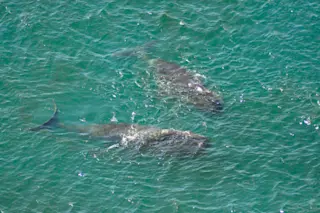HIGH WATER
Off the coast of North Carolina, a ship is nearly engulfed by storm-tossed seas. Physicists now know that unstable conditions often give rise to waves that are freakishly large yet surprisingly predictable.
Alfred Osborne’s style is not to do one thing at
a time. At the moment he is trying to get a major wave experiment going at a huge tank in Trondheim, Norway. But his PC refuses to communicate with his Mac. And while he’s working on that, he’s trying to revise some formulas that will drive the waves in the tank. His young colleagues from Turin, Italy—Miguel Onorato and Carlo Brandini, both unshaven, uncombed, and turned out in travel-worn attire—make suggestions in Italian, then pass Osborne a pen and a paper full of equations. He answers in English, redoes the equations, and passes back the pen and paper. They respond in English. He answers in Italian ...














